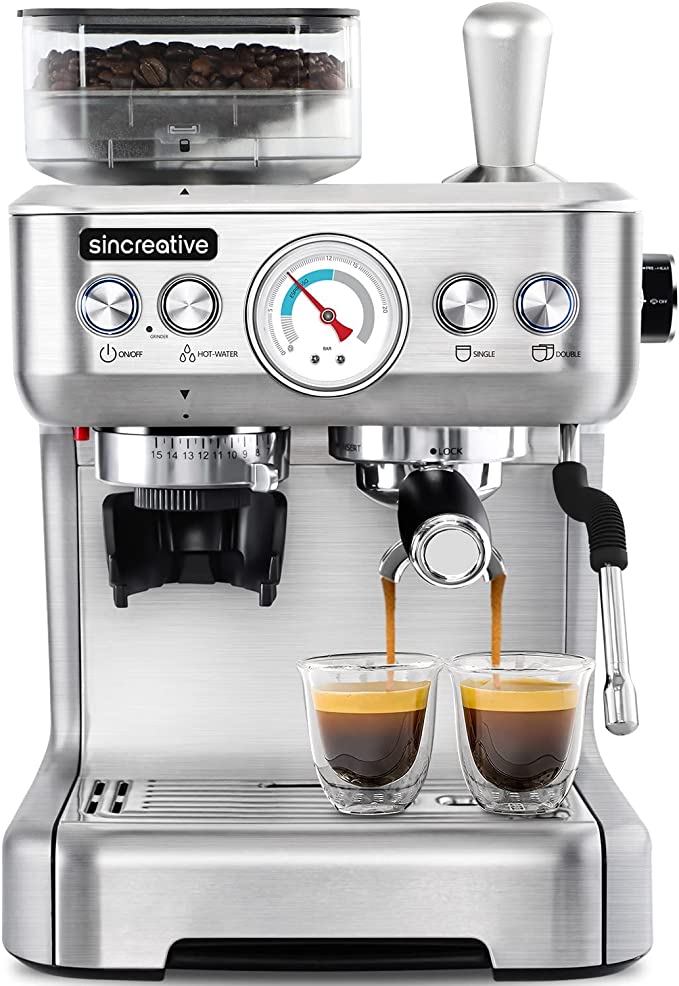The Home Barista's Guide to the SHARDOR CG836: Mastering Your Grind for Any Brew
Update on Oct. 29, 2025, 4:19 p.m.
For many of us, the journey into better coffee starts with a simple realization: the beans are only half the story. You can have the most exquisite, ethically sourced, perfectly roasted beans, but without the right grind, their potential remains locked away. This is where a crucial piece of equipment enters the scene, a true game-changer that often sits unassumingly on the countertop: the burr grinder.
If you’re reading this, chances are you’ve made that leap. You’ve brought home the SHARDOR CG836 Coffee Grinder Burr Electric, and you’re ready to move beyond the inconsistent chop of a blade grinder or the flavor loss of pre-ground coffee. This guide isn’t just a manual; it’s a masterclass. We’re going to treat the CG836 not just as a machine, but as your personal instrument for unlocking a world of flavor. We’ll delve into the science of the grind and, most importantly, provide a practical, step-by-step approach to finding the perfect setting for whatever brew you’re craving.

The ‘Why’ Before the ‘How’: A Quick Grind Science Primer
Before we touch the dials on the SHARDOR CG836, let’s understand what we’re actually trying to achieve. When hot water meets coffee grounds, it starts a process called extraction. The water dissolves flavors, oils, and acids from the coffee. Our goal is a balanced extraction.
- Under-extraction: If your grind is too coarse, water flows through it too quickly. It doesn’t have enough time to grab all the good stuff. The result? A coffee that tastes sour, thin, and underdeveloped.
- Over-extraction: If your grind is too fine, the water struggles to get through and stays in contact for too long. It extracts everything, including the harsh, bitter compounds. The result? A coffee that is astringent, bitter, and hollow.
The secret to balanced extraction is consistency. A burr grinder like the CG836 doesn’t violently chop beans like a blade grinder; it mills them between two abrasive surfaces (burrs) to a uniform particle size. This consistency ensures that every coffee particle extracts at roughly the same rate, giving you a clean, balanced, and predictable cup every single time.
Your Instrument: Deconstructing the SHARDOR CG836
Let’s look at the key features of the CG836 and understand their role in our quest for the perfect cup.
The Grinding Engine: Metallic Flat Burrs
At the heart of the CG836 is a metallic flat burr system. Flat burrs consist of two parallel rings that mill the beans to a highly consistent size as they travel from the center to the outside edge. This design is excellent for producing a uniform grind, which is fundamental for clean-tasting drip coffee and crucial for preventing “channeling” in espresso—where water punches holes through the coffee puck, leading to uneven extraction. The metal construction ensures durability and sharpness, vital for long-term performance.
The Control Panel: 25 Grind Settings & Digital Timer
This is where you conduct the orchestra. The SHARDOR CG836 offers 25 distinct grind settings, giving you precise control over the distance between the burrs. This range allows you to move seamlessly from a very coarse grind for a French Press to an ultra-fine powder needed for espresso.
The adjustable 40-second digital timer is your key to consistency in dosing. Great coffee is repeatable. By finding the right time setting for your desired amount of coffee (e.g., 10 seconds for a single cup), you can ensure you’re using the exact same dose every morning, eliminating a major variable in your brewing process. It also encourages grinding on demand, which is critical because coffee begins to lose its aromatic compounds to oxidation almost immediately after grinding.

The Practical Masterclass: Dialing in Your SHARDOR CG836
This is the core of our guide. Forget vague advice; let’s talk numbers. The following are starting points. Your specific beans, their roast level, and even their age will require slight adjustments. The goal here is to teach you how to listen to your taste buds and fine-tune your grind.
1. French Press (Immersion Brewing)
- The Goal: A very coarse grind. During the 3-4 minute steep, a fine grind would turn your coffee into a bitter, sludgy mess. We need grounds coarse enough to allow for full flavor extraction without dissolving into sediment.
- SHARDOR CG836 Starting Point: Settings 20-24. It should resemble the texture of coarse sea salt.
- How to Dial-In:
- Tastes muddy and overly bitter? Your grind is too fine. Move to a higher number (coarser setting).
- Tastes weak, sour, or tea-like? Your grind is too coarse. Move to a lower number (finer setting) one click at a time.
2. Drip Coffee Makers & Pour-Over (Percolation)
- The Goal: A medium grind, somewhere between table salt and coarse sand. The grind needs to be fine enough to create some resistance for the water, but coarse enough to allow it to flow through at a steady pace.
- SHARDOR CG836 Starting Point: Settings 12-18. This is a wider range because automatic drip machines and manual pour-overs (like a V60) can vary.
- How to Dial-In:
- Brew time is too long, and coffee tastes bitter? Your grind is too fine, choking the flow of water. Go coarser (a higher number).
- Water rushes through too fast, and coffee tastes sour? Your grind is too coarse and isn’t providing enough resistance. Go finer (a lower number). For pour-over, aim for a total brew time of around 2:30 to 3:30 minutes as your target.

3. Espresso (High-Pressure Brewing)
- The Goal: A very fine, consistent grind, like powdered sugar. This is the most demanding method. The fine grounds must be packed into a dense puck to create enough resistance for the machine’s 9 bars of pressure, allowing for a concentrated extraction in about 25-30 seconds.
- SHARDOR CG836 Starting Point: Settings 1-5. This is where the CG836’s precision at the fine end is tested.
- How to Dial-In: This requires precision.
- Shot pulls in under 20 seconds (a “gusher”) and tastes sour? This is a classic sign of under-extraction. Your grind is far too coarse. Go finer (a lower number).
- Shot takes over 35 seconds to pull (it “chokes”) and tastes intensely bitter? This is over-extraction. Your grind is too fine. Go coarser (a higher number).
- The goal for a standard double shot is roughly 18 grams of coffee in, yielding about 36 grams of liquid espresso in 25-30 seconds. Use the timer on the CG836 to get your 18-gram dose consistent, then adjust the grind setting to hit your time target.

Beyond the Grind: Maintenance for Peak Performance
A great tool deserves proper care. Coffee beans contain oils that, over time, can build up on the burrs and in the grind chamber. These old oils become rancid and will impart stale, unpleasant flavors onto your fresh coffee.
The SHARDOR CG836 is designed for easy cleaning. The bean hopper, top burr, and grind chamber are all removable. Once a week, or whenever you change bean types, unplug the grinder, remove these parts, and use the included brush to clear out all residual grounds and oils. This simple five-minute ritual is one of the most impactful things you can do to ensure your coffee always tastes pure and vibrant.
Your Journey to Flavorful Coffee
Mastering the grind is the single most significant step you can take to elevate your home coffee experience. It’s a journey from guessing to knowing, from inconsistency to delightful predictability. The SHARDOR CG836 Coffee Grinder is more than just an appliance; it’s a reliable and precise instrument that empowers you to take control of the brewing process.
By understanding the science of extraction and using the practical starting points in this guide, you can begin to experiment with confidence. Pay attention to the taste in your cup, make small adjustments, and you will unlock the nuanced, delicious, and deeply satisfying potential hidden within every single bean. The art and science are now in your hands.








































